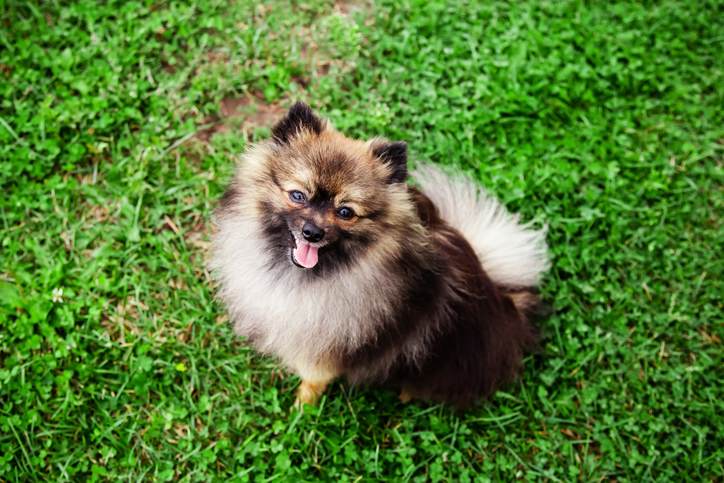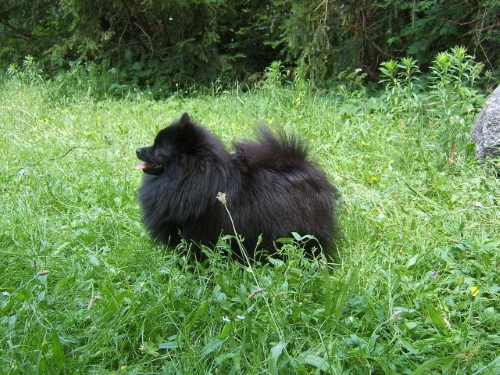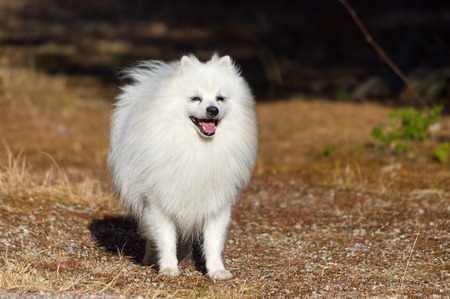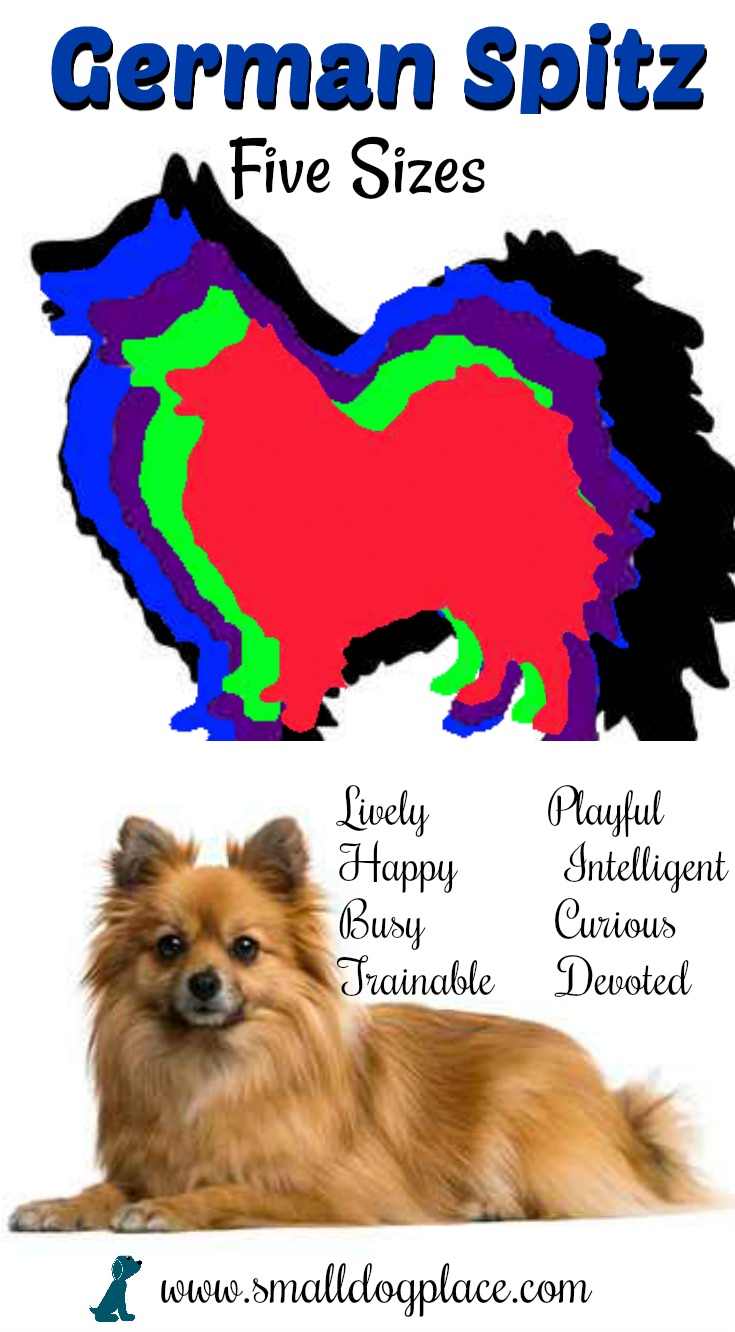- Small Dog Place Home
- A-Z Breeds A to M
- German Spitz
German Spitz
By Janice Jones |Last Updated 04-29-2024
The German Spitz is an affectionate and smart dog that loves to be with its pack. Their playful and curious energy is ideal both for families and individuals.
Whether they sound off to alert you to the presence of a rabbit on the front lawn or playing hide and seek with one of your shoes, any owner would love the mischievous type of humor that these tiny Spitz bring.
Quick Facts About the German Spitz
- This breed is also referred to in German as a “mistbeller,” referring to their historical tendency to bark atop mounds of dung.
- German Spitz, while being the breed title, also represents the various types of Spitz breeds that originate from Germany.
- Ancestors of the breed were referred to as a Pomeranians, despite their differences with the modern Pomeranian.
Other Names Used: Deutscher Spitz, Mistbeller, Spitz
Affiliations: AKC Non-Sporting Group, AKC FSS group, FCI
Size
Height: 29-36 cm (11.5-14 inches)
Weight: 10.5 - 11.5 kg (23-41 lbs)
Coat Type: Long, thick double coat.
Colors: Brown, Red, Orange, White, Cream, Black, Black and Tan, Wolfgray
Markings: Sable, Parti-Colour
Country of Origin: Germany
Activity Level: The German Spitz is fairly energetic, requiring exercise or plays to help quell their antsiness.
Life Expectancy: 13-15 Years
Good with Children: This breed coexists well with the kids for a myriad of reasons. The first and most noticeable, desirable quality is the dog’s size. These dogs are not likely to injure smaller children on accident by bumping into or knocking them over.
However, small children should still be supervised when playing. Their warm, playful personality when properly socialized is also ideal for sharing the house with kids. Any children should be taught how to handle the dog before play, of course.
Good with Other Pets: While they play well with the kids, fellow canines are approached with an understandably higher level of caution. That being said, Spitz who are raised with other dogs and are well socialized will have no issue with them.
The breed has a high prey drive, however, given its history, so it’s important to socialize them early with smaller pets and supervise them when together. With this breed, the background of experience from which it comes decides the perspective that it has with other dogs.
Sizes of the German Spitz
- German Spitz (Klein) or Miniature Spitz: 8.8 to 11.0 lb. (4-5 kg.) and 9 - 11 inches (23-29 cm)
- German Spitz (Mittel) Medium Spitz 15-22 lb. (7-10 kg.) and 12 -15 inches (30 - 38 cm)
- Grossspiz Dog: Large: 15.5 - 17.5 inches (40 - 44 cm) and 37.5 - 42 lb. (17-10 kg)
- Wolfspitz or Keeshond: Largest: – 17 - 19 inches (43-48 cm) and 44 -66 lb (20-30 kg)
Zwergspitz (the smallest of the German Spitz dogs is also called the Pomeranian
History
The name of the German Spitz gives a pretty good idea as to its origins. However, their history is not that simple. Spitz type dogs are considered one of the oldest dog types, if not the oldest.
Telltale features of these dogs can be found in a myriad of breeds. Just because they may be lacking “Spitz” in the title doesn’t mean that they don’t also hail from this ancient type of dog.
These dogs have been utilized for a variety of tasks, from the stone age to the present. These dogs, unlike some others whose instincts were diverted into fields that they’d be useful in, are thought to have been bred to be less animal.
The German Spitz was meant to be a companion and a useful farm dog. However, their personality and physique show that they were much more successful in the latter.
Germany was once made up of multiple kingdoms and feudal states, rather than the unified country we know today. In each of these kingdoms, it would not be a hard task to find one of these Spitz.
They were used for herding livestock, as well as watchdogs. Some trading caravans would have these dogs watch their goods and warn of the presence of strangers by barking. Due to the versatility of the breed on top of its already famous reputation, these dogs were everywhere.
As a result of their popularity, the consistency of the breed became hard to maintain. Some were smaller than others, some had different coat colors, and they all often went by the same name. This confusion is likely the reason for why there are both German Spitz type dogs and the singular breed.
As the size differences became more established, the Germans named them accordingly. The larger ones being the Wolfspitz or the Grossespitz, with the smaller ones being called Kleinspitz or Mittelspitz.
The breed reached its peak of popularity when it became a favorite of the English royalty in the 18th century. When adopted by the English, however, it was referred to as a Pomeranian.
This was because of the misconception that they came from a place called Pommern when realistically they could be found throughout Europe. Queen Victoria was also a supporter of the breed, more in favor of the smaller Spitz.
With their usefulness as a farm and watchdog paired with their popularity as companions, the population of the German Spitz and its subsets continued to increase.
These dogs grew in number likely until the eruption of World War 1. Dog breeds throughout Europe were ravaged by this conflict, especially those within Germany.
The economic hardship that the people faced meant that companion dogs were not the priority. Had the breed not been so useful in other practical applications, it’s likely that there would be even fewer.
World War 2 was no exception for this breed and many others. On top of their unfortunate situation in their home country, there was a lot of disdain for Germany and its people at the time. Anything tha
had to do with the country was frowned upon or met with understandable reluctance. It was around this period that the German Spitz made its way into the US. The dogs that made it to the new world were renamed to the American Eskimo dog, reiterating the hatred towards Germany.
Despite the hard times that were faced by the breed in the early 20th century, they apparently bounced back to be what they are known as today. The economic boom that the US experienced after the war meant that the Eskimo dog, as well as the Spitz, saw an increase in numbers.
Now that people could afford to have dogs again, many breeds slowly began to recover from the population dip of the two world wars.
Despite never having been registered as an official breed in the AKC due to its myriad of sizes and appearances, the German Spitz is recorded in the AKC Foundation Stock Service.
Personality
The German Spitz is a tried and tested breed, whose companionship and versatility has stood the trials of time. They are known to be playful, bouncing and happy dogs.
They love to be with their pack, enjoying spending time playing with their owners or fellow canines. As a result, they don’t like to be left alone and tend to have separation anxiety.
These dogs are great for families with kids, so long as they are raised and trained properly. Their size is ideal for this, as it’s doubtful that they could accidentally injure a child.
It’s ideal to have the dog raised with the kids, as it will make them more familiar and comfortable around them. This being said, it’s important that any small children are supervised and taught how to play with the dog appropriately.
This breed can get to be a bit mischievous when left to its own devices, especially when they’ve been cooped up in the house all day.
Daily exercise will not only keep these dogs healthy, but it will help quell some of the anxious energy that they can build up and take out of your household. Something as simple as a walk is enough to keep them at bay, helping to create a happier healthier dog at the same time.
The German Spitz tends to be a direct reflection of its owner’s treatment. The best way to get a Spitz to be kind to you is to be kind to it. This is very important in the training process, as it’s ideal to reward good behavior rather than punish mistakes.
Consistency is important with these dogs as well, as they are smart enough to sniff out weaknesses in their owners.
These Spitz are known to be hospitable towards strangers and friends of the family when socialized properly.
This being said, it’s hard to thoroughly train out their natural suspicion towards unfamiliar faces, as their instinct tells them to be wary and alert.
A Spitz that trusts its owner, however, will trust their judgment with people too, and will likely be playing with any guest as soon as it feels comfortable.
Socialization is key to this, as the more experience they have with unfamiliar faces, sights and sounds, the less anxious they will feel in new situations.
On top of being hospitable towards strangers, these dogs can coexist very well with fellow canines and pets.
They don’t have a high prey drive, so small pets tend to be left unbothered by these dogs. It’s ideal to have a Spitz raised with other dogs rather than have it be introduced to them as an adult, as they are very aware of who is in their pack.
Sharing the house with other dogs is also a great way to manifest some of that anxious energy that would otherwise be thrown into destroying your furniture.
The German Spitz doesn’t have a very strong prey drive. However, it’s still a dog. It’s important that they have some sort of enclosure to prevent them from chasing a squirrel into the street.
Using an electric fence is applicable, and their size makes this easy, as they have much less tolerance for pain. Some owners will opt for a physical fence, but it is not necessary with this breed.
These dogs tend to be fairly easy to train, as their intelligence allows them to pick up on things quickly. That being said, it’s all about the owner’s approach to the training process.
The German Spitz needs a pack leader, as without one they may assume the position themselves. If these dogs are given the opportunity to take charge, the training process will become much more difficult.
This breed is known to be fairly vocal, with evidence of this being found in their historical position as watch dogs. They will alert their owner to any changes in their environment, and this can be a nuisance to some.
For apartment living, it’s very important to condition them to not bark at every little thing. It’s ideal that they live in a somewhat sparsely populated area, as any sort of city will only provide them with more things to bark at or be anxious about.
Grooming
The German Spitz is not known to be a difficult dog to groom. Their small bodies are covered in a double layer coat, and they are not heavy shedders for the majority of the year.
They still require regular brushing, however, and it is recommended that they are brushed 1-2 times a week. These dogs are known to shed fairly nominally and do not have too much of smell. They only need bathed when needed, or at least every other month.
It’s important that a German Spitz has its teeth brushed along with its hair. While fresh breath for dogs isn’t precisely a priority, dental health absolutely is.
Smaller dogs are more prone to dental issues, so it is essential that the proper dental care is provided. Regular brushing will remove plaque, keep breath fresh, and prevent tartar buildup. It’s recommended that they have their teeth brushed 2-3 times a week.
All dogs need to have their nails cared for. While some breeds tend to file down their nails naturally through play, most require this important part of the breeding process.
If a dog’s nails become too long, they may become uncomfortable and irksome to them.
Most Spitzes will need their nails clipped at least once a month. A telltale sign of long nails is when they can be heard clicking against the ground as the dog moves.
Checking and cleaning a dog’s ears is an important part of the grooming process as well. Dogs with more open ears, such as the Spitz, have less of an issue due to the greater amount of airflow they get.
This being said, it’s important to check and clean a dog’s ears at least once a week. This will remove excess wax, as well as any bacteria or things that may have managed to get caught inside.
Health Concerns
The German Spitz is an all around healthy dog, with many breeds of their size boasting a relatively long lifespan of 13-15 years. Dogs are like people, however, and they can get just as sick. This being said, some breeds are more prone to certain diseases and conditions than others.
Prevention is by far the best medicine. A dog’s healthy lifestyle will be reflected in their absence of health issues, meaning a dog with an unhealthy lifestyle is, of course, more bound to be afflicted. While it’s possible that they will not be affected by any one of these conditions, it’s still important to be aware of them when purchasing a German Spitz:
- Retinal Dysplasia
- Retinal Atrophy
- Loss of Eyesight/ Cataracts
- Joint issues
- Patellar Luxation
- Idiopathic Epilepsy
This is not the absolute max of health issues that the breed may be affected by, as all dogs are at risk of things like ticks and fleas. These are just a few of the conditions that the breed itself is prone to.
On top of maintaining good health practices with the dog, it’s important that purebred dogs are purchased from a reputable breeder.
Any good breeder will know the breed inside and out, being capable of answering any questions you may have.
They should also be capable of passing health checks for their dogs, as bad breeders will try to suggest that their dogs are an exception.
Pros and Cons
Pros
- Make good watchdogs
- People lovers when trained properly
- Intelligence makes them easy to train
- Housebreaking is also easy due to intelligence
- Affectionate and loving towards good owners.
Cons
- Can be a bit mischievous
- They tend to be fairly vocal.
- They have a strong prey drive making them unreliable off leash
- Hate being left alone, a lot of separation anxiety.
- Shedding is an issue during drastic temperature changes, such as in autumn or spring.
- Fairly popular dog. Finding a reputable breeder is important.
Did You Know?
Having been so popular with Queen Victoria, they were at one point referred to as “Victorian Poms,” named according to their misnomer and royal aficionado.
National Breed Club: http://www.gsboc.co.uk/
About Janice (author and voice behind this site)
Having lived with dogs and cats most of her life, Janice served as a veterinary technician for ten years in Maryland and twelve years as a Shih Tzu dog breeder in Ohio.
Her education includes undergraduate degrees in Psychology with a minor in biology, Early Childhood Education, and Nursing, and a master's in Mental Health Counseling.
She is a lifelong learner, a dog lover, and passionate about the welfare of animals. Her favorite breed for over 50 years has been the Shih Tzu, but she has also lived with Poodles, Maltese, Yorkshire Terriers, Beagles, English Bulldogs, Carin Terriers, and a Cocker Spaniel.
When not writing, reading, and researching dog-related topics, she likes to spend time with her eight Shih Tzu dogs, husband, and family, as well as knitting and crocheting. She is also the voice behind Miracle Shih Tzu and Smart-Knit-Crocheting
Does This Article Deserve Your Thumbs Up?
We always appreciate your support and encouragement. Your thumbs up means so much to us. Please like this article.
If you find this page or any page on Small Dog Place Helpful, or useful in anyway, I'd love it if you would click the small heart found on the bottom right of each page.
You can also share or bookmark this page -- just click on the:

Free Monthly Newsletter
Sign Up for Our Free Newsletter and get our Free Gift to You.
my E-book, The Top 10 Mistakes People Make When Choosing a Dog (and how to avoid them)








